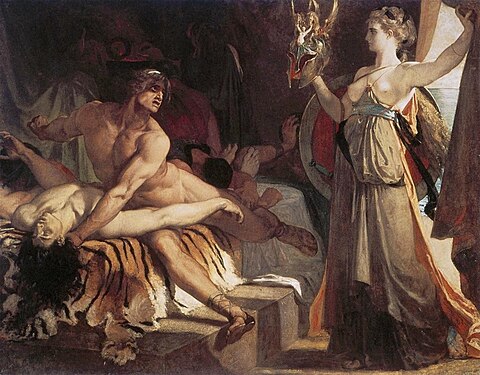Henri Regnault
Henri Regnault | |
|---|---|
 | |
| Born | Alexandre Georges Henri Regnault 31 October 1843 Paris, France |
| Died | 19 January 1871 (aged 27) Rueil-Malmaison, France |
| Education |
|
| Notable work | French Orientalism |
| Parent |
|
| Awards | Prix de Rome (1866) |
| Military career | |
| Allegiance | |
| Branch | French Army |
| Service years | 1870–1871 |
| Battles/wars |
|
Alexandre Georges Henri Regnault (31 October 1843 – 19 January 1871) was a French painter.
Biography
Regnault was born in
The past in Italy did not touch him, but his illustrations to Wey's Rome[2] show how observant he was of actual life and manners; even his Automedon (School of Fine Arts), executed in obedience to Academical regulations, was but a lively recollection of a carnival horse-race. At Rome, moreover, Regnault came into contact with the modern Hispano-Italian school, a school highly materialistic and inclined to regard even the human subject only as one amongst many sources of visual amusement. The vital, if narrow, energy of this school told on Regnault with ever-increasing force during the few remaining years of his life.[1]
In 1868 he had sent to the Salon a life-size portrait of a lady in which he had made one of the first attempts to render the actual character of fashionable modern life. While making a tour in Spain, he saw General Juan Prim pass at the head of his troops, and received that lively image of a military demagogue which he afterwards put on canvas, somewhat to the displeasure of his subject. But this work made an appeal to the imagination of the public, while all the later productions of Regnault were addressed exclusively to the eye.[1]
After a further trip to North Africa, abridged by the necessities of his position as a pensioner of the school of Rome, he painted Judith, then, in 1870, Salomé, and, as a work due from the Roman school, dispatched from Tangier the large canvas, Execution Without Hearing Under the Moorish Kings. The Franco-Prussian War arose, and found Regnault at the Battle of Buzenval, where he was killed on 19 January 1871.[1][3]
His friend, the composer
Gallery
-
Automedon with the Horses of Achilles (1868), Museum of Fine Arts, Boston
-
Salomé (1870), Metropolitan Museum of Art
See also
References
Footnotes
Bibliography
- This article incorporates text from a publication now in the public domain: Chisholm, Hugh, ed. (1911). "Regnault, Henri". Encyclopædia Britannica. Vol. 23 (11th ed.). Cambridge University Press. p. 46.
- Gotlieb, M. (2016). The Deaths of Henri Regnault. University of Chicago Press.




